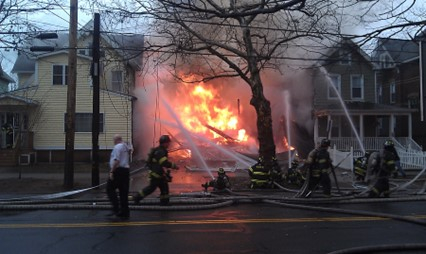
Here is a good example of exposure protection. The Rule of 15 certainly applies here, at least from the distance point of view. In many older cities, it is rare to have a fire without an exposure problem. In North Hudson, the Rule always applies…usually to several of the exposures. Here, whatever was burning in the middle was long lost, but the fact that the buildings on either side are not involved is a function of simple physics as applied by Command -- keep the exposed walls wet. This is based on the inevitable fact that sometimes buildings will burn down. The key to your strategic process should be to not burn down anymore. This requires personnel and water and a plan. As Chief Brunacini said, “Fire, smoke, and heat follow natural laws. They are not natural suggestions. They are laws. The only thing they understand is water.” Here we see a bunch a lot of water in the form of large diameter handlines protecting the two exposures. As far as I can tell, there are also lines on the interior of both exposures as well. In this fire, the same operations may be taking place in the C exposure to the rear also. That is how it supposed to be done. Lines inside, lines outside, keeping the walls wet. I would also have Division Commanders and a Ladder company in each exposure as well to supervise and communicate in the case of the Division Commanders, and to open walls and ceilings as needed in the case of the Ladder personnel. Water supply and the securing of additional sources must be thought about early, organized, and carried out before the fire runs away from the water supply. Note the power lines on side A. This prevents much of the master stream operation in many jurisdictions, but if you rely on those towers and ladder pipes all the time in lieu of stretching some old-fashioned large diameter lines, you will lose your exposures. It‘s OK to burn down one building. It is not Ok to burn down more when you could have saved them. The only thing I don’t like here is that the guys on the exposure lines are right under the wires. Although they don’t appear to be threatened now, that may not have been the case earlier in this fire when the fire building was still a building. Possibility of compromise by heat may be undetectable from the street. Keep that in mind and keep your distance.

Here is a Union meeting (or maybe an incident evaluation) on the A side. The strategy was successful, and the job well done. Although the original fire building is just rubble (and who knows if it was “standing rubble” upon arrival), the exposures are intact. Note the heat damage on the exposed walls. Remember that behind the siding may be asphalt siding which ignites and burns ferociously. In newer buildings, it is likely to be OSB, which burns and radiates heat just as ferociously. Keep it from becoming part of the problem by the early deployment and application of protective lines. They’re still standing under the wires.
Photos courtesy of Frank Ricci